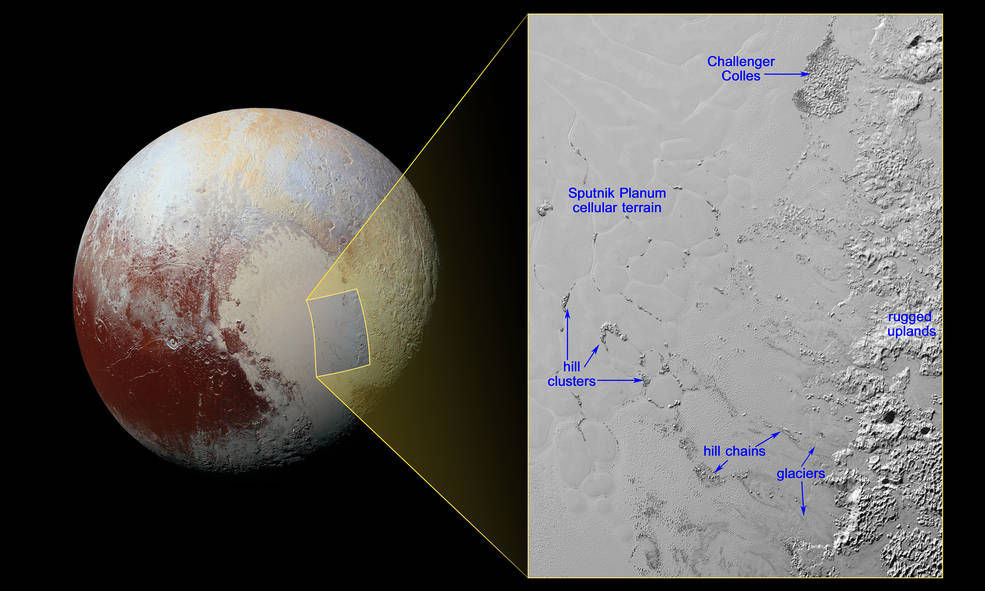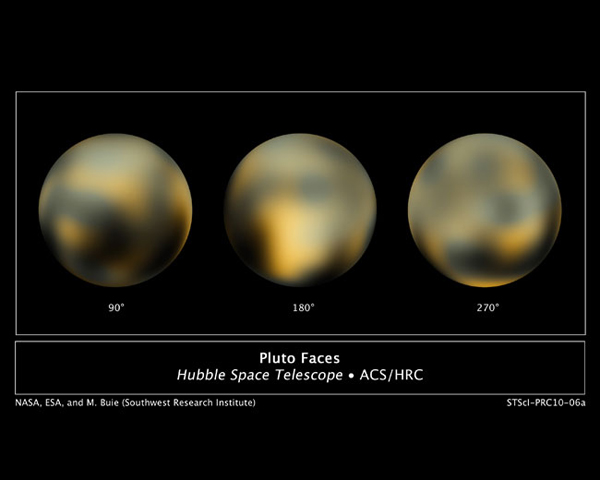
Mini-mountains of water-ice creep across Pluto's surface, carried slowly along by the dwarf planet's nitrogen-ice glaciers, a newly released photo suggests.
The image, which was captured by NASA's New Horizons spacecraft during its historic Pluto flyby last July, shows that the vast Sputnik Planum region within the dwarf planet's famous "heart" is studded with chains and clusters of water-ice hills.
"Because water ice is less dense than nitrogen-dominated ice, scientists believe these water-ice hills are floating in a sea of frozen nitrogen and move over time like icebergs in Earth's Arctic Ocean," NASA officials wrote in a description of the image, which was released Thursday (Feb. 4). "The hills are likely fragments of the rugged uplands that have broken away and are being carried by the nitrogen glaciers into Sputnik Planum." [Photos: NASA's New Horizons Pluto Mission]
The central part of Sputnik Planum features massive polygonal blocks of nitrogen-ice. These distinctive cell-like structures were probably produced by thermal-convection processes, which in turn are driven by Pluto's mysterious internal heat, New Horizons team members have said.
When the ice hills reach this convection-cell area, they apparently get pushed to the cells' margins, accumulating there. One such clump visible in the image is about 37 miles (60 kilometers) long and 22 miles (35 km) wide, NASA officials said. The mission team has informally named this clump Challenger Colles, to honor the seven astronauts who died in the space shuttle Challenger explosion on Jan. 28, 1986.
New Horizons took the newly released image on July 14, 2015, when the probe was about 9,950 miles (16,000 km) from Pluto. (About 12 minutes later, New Horizons made its closest approach to the dwarf planet, getting within 7,800 miles, or 12,550 km, of Pluto's surface.)
The image, which was captured by New Horizons' Multispectral Visible Imaging Camera instrument, covers a stretch of land measuring about 300 miles by 210 miles (480 km by 340 km) and features a resolution of 1,050 feet (320 meters) per pixel, NASA officials said.
Get the world’s most fascinating discoveries delivered straight to your inbox.
Pluto, the most famous dwarf planet in our solar system, underwent a well-publicized (and somewhat controversial) reclassification that took away its title as the ninth and most distant planet from the sun. So, how well do you know this fascinating world?
Pluto Quiz: How Well Do You Know the Dwarf Planet?
New Horizons is still beaming home the huge data set it obtained during the flyby; all of the images and measurements should be on the ground by this coming fall, mission team members have said. The spacecraft is currently cruising toward an encounter with a small object about 1 billion miles (1.6 billion km) beyond Pluto called 2014 MU69. New Horizons will study this body up close on Jan. 1, 2019, if NASA approves and funds a proposed extended mission.
Follow Mike Wall on Twitter @michaeldwall and Google+. Follow us @Spacedotcom, Facebook or Google+. Originally published on Space.com.





